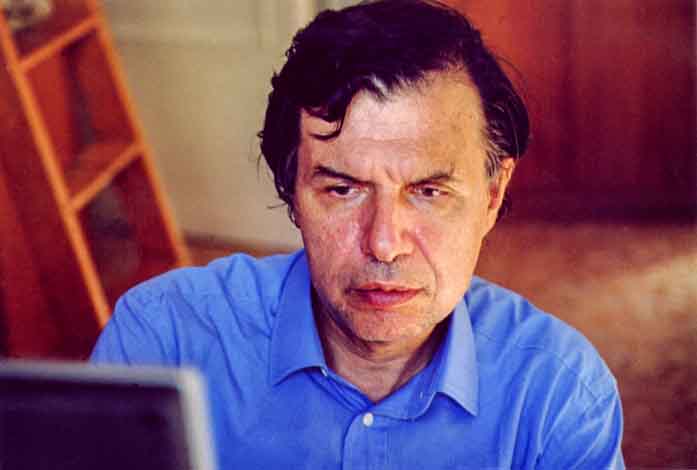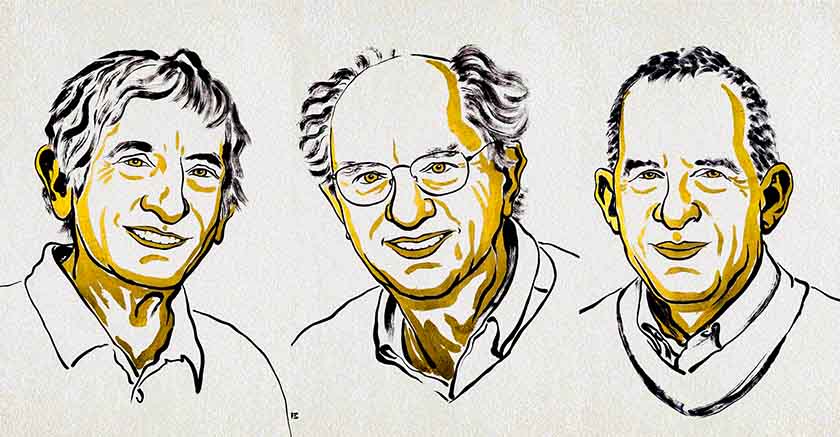The 2021 Nobel Prize in Physics was awarded to a total of three winners, the maximum number allowed by the rules of the prize, "for a groundbreaking contribution to our understanding of complex systems."

Last year, the Nobel Foundation raised the prize amount to SEK 10 million. This equates to about 950,000 euro ($1,074,000). The winners also receive a medal and a diploma. Although the prize was awarded to three laureates, the sum is clearly divided into two parts this year.
Half of this award went to Syukuro Manabe and Klaus Hasselmann "for physically modeling the Earth's climate, quantifying variability and reliably predicting global warming" and the other half to Giorgio Parisi "for discovering the interplay of disorder and fluctuations in physical systems from atomic to planetary scales" .
All three winners this year received an award for research into chaotic and seemingly random phenomena and their modeling. Giorgio Parisi has been awarded for his revolutionary contribution to the theory of disordered materials and random processes. Syukuro Manabe and Klaus Hasselmann laid the foundations for our understanding of the Earth's climate and how humanity affects it.
Unfortunately, their achievements are difficult to describe in a readily accessible way. In this article, we will only focus on one half of this year's Award, the part awarded to the Italian theoretical physicist Giorgio Parisi, whose research has focused on quantum field theory, statistical mechanics and complex systems.
Complex Systems
A common thread that connects all this year's winners is "complex systems". This year's Nobel Prize winners contributed to the scientific treatment of such systems.
Complex systems are those governed by chance and disorder. The science of complex systems comes from the foundations of physics, but extends to the areas of biology, economics, medicine, social sciences and the humanities, and well beyond. Complexity is, in a sense, the reaction to the traditional scientific reductionism, which often ignores the holistic aspect of systems and focuses on the elements of systems in isolation from their operation as a whole. The science of complexity allows one to analyze the system in its entirety as one holistically perceived whole.
Complex systems are related to such concepts that have entered the scientific circulation a long time ago, such as chaos, time-space structures, fractals, non-linearity, open systems, systems far from equilibrium, neural networks, self-organization, and artificial intelligence, in particular — machine learning. All of this, one way or another, comes from, or relates to, the state of disorder called chaos.
This year's Nobel Prize in physics focuses on the complexity of physical systems, from the largest scales that humans experience, such as the Earth's climate, to the microscopic structure and dynamics of mysterious yet common materials such as glass.
The emergence of disorder from deterministic order, and with it, multiple scales in space and time, is characteristic of complex systems. Understanding the nature of such a disorder presents an enormous scientific challenge.
The World Is... Complicated
The human tendency to simplify and omit details, to constantly generalize, helps us organize concepts and assimilate new information, rather than drown it it, but it does not necessarily help us accurately describe the real world in its entirety. Nature always surprises us with its complexity — everything is always more complicated than it initially seems.
When viewed from a distance, complex physical objects may appear simple. Simply put, the Earth is just a big sphere; an atom is, after all, a small, elastic ball, resembling a billiard ball... However, from atoms to planets, when we look more closely, we always discover an increasingly complicated internal structure. We become inundated with complexity at every scale.
This year's Nobel Prize in physics went to people whose research helped to finally understand that Nature should be treated as a complex system in which all factors must be taken into account simultaneously. It is also a sign of appreciation for basic and interdisciplinary research, which has often been neglected by the Nobel Prize Committee.
In 2021, the Nobel Committee decided to award scientists who contributed to understanding the complexity of our world. Their research touches on a very important aspect of the functioning of the entire Universe — the one that requires a holistic approach to the problem, not just examining it piece by piece.
Complexity Leads to Chaos
Complex systems are characterized by randomness and disorder, and are difficult to understand. This year's Award promotes new methods of describing them and predicting their long-term behavior.
Systems whose principles of operation are essentially simple, can exhibit surprising complexity beyond traditional analysis. An example may be the gravitational interaction, supposedly described quite thoroughly by Newton. Newton's laws of gravity and motion governing bodies allow us to describe the trajectory of, for example, the Moon around the Earth with sufficient accuracy to successfully send a spacecraft there that can also reliably return to Earth. However, when we introduce a third body into such a gravitational system, the problem takes on a completely different nature.
Initiating this field — the analysis of chaos — is commonly credited to Henri Poincaré, the 19th century French genius thinker, for discovering that the long-term behavior of the three bodies was infinitely more complex than expected and led to effectively chaotic behavior.
Chaos, contrary to popular belief, is not just a "big mess". In science, the term chaotic is defined as pertaining to systems that are highly sensitive to a very small disturbance in the initial parameters. But these are still systems with characteristics that can be described mathematically, though not in a traditional way.
The Ways of Complex Systems
All scientific and mathematical models are some approximations to reality, simplifications. All approximations, be they mathematical or computing numerically with machines, are valid only within certain limits. The true art of science is to make rational approximations. Scientific rigor is about knowing exactly when a model is no longer applicable.
Modern research of complex systems derives from statistical mechanics developed in the second half of the 19th century by James C. Maxwell, Ludwig Boltzmann, and J. Willard Gibbs. Statistical methods were necessary to describe systems such as gases or liquids, which are made up of a large number of particles. The method had to account for the random movement of the particles, so the basic idea was to calculate the mean effect of the particles instead of testing each particle separately. For example, the temperature in a gas is a measure of the average energy of the gas particles.
Statistical mechanics was a great success because it provided a microscopic explanation of the macroscopic properties of gases and liquids, such as temperature and pressure. However, when viewed more closely, traditional statistical methods fail.
The molecules in the gas can, in simple terms, be considered tiny spheres that circulate at a speed that increases with increasing temperature. When the temperature drops or pressure increases, the spheres first condense into a liquid and then into a solid. This lump is often a crystal in which the balls are arranged in a regular pattern. However, if this change occurs quickly, the balls can form an irregular pattern that does not change even as the liquid is further cooled or compressed. If the experiment is repeated, the balls will take on the new pattern. And here the question arises: Although change occurs in exactly the same way, why do the results differ then?
Giorgio Parisi to the Rescue
Giorgio Parisi was born in Rome in 1948. He obtained his doctorate in 1970 at the University of La Sapienza, where he remains a professor to this day. As a theoretical researcher, according to the Nobel committee, he found order in the apparent chaos, patterns that make it possible to understand the behavior of various physical objects.

Giorgio Parisi (Source: Wikipedia)
Around 1980, Giorgio Parisi discovered hidden patterns in disordered, complex materials and made his discoveries about seemingly random phenomena which, however, are governed by hidden rules. His discoveries are among the most important contributions to the theory of complex systems. They make it possible to understand and describe many different and seemingly completely random materials and interactions, not only in physics, but also in other, very different fields, such as mathematics, biology, neuroscience and machine learning.
He conducted research on the so-called spin glass, i.e. a material in which spins (magnetic moments) escape the expected orderly description of the system.
Spin Glass and Frustration
The material of Parisi's original work was spin glass, a special type of metal alloy in which iron atoms are randomly mixed into a lattice of copper atoms.
Iron is a magnetic material that has a tendency to position itself predictably in a magnetic field. Although there are few iron atoms in spin glass, they change the magnetic properties of the material in a radical and very puzzling way. Each iron atom behaves like a small magnet, or spin, influenced by other iron atoms in its vicinity. In a regular magnet, all the spins point in the same direction, but in spin glass they are "frustrated": some spin pairs want to point in the same direction and others in the opposite direction — so how does one find the optimal orientation?
Their optimal positioning in the material initially seems to be random. In the event of a minor breach of the existing order, it leads to unpredictable and significant changes. The difficulty was to explain why the spins of the atoms in the system take the orientation they do, and why the whole thing can reach the optimal state, in which the magnetic spins reach a stable arrangement.
In the introduction to his book, Parisi writes that studying spin glass was like watching human tragedies in Shakespeare's plays. If you want to be friends with two people at the same time, but they hate each other, it can be frustrating. All the more so in the case of a classic tragedy, in which both strongly emotional friends and enemies meet on stage. How then to minimize the overall emotional charge in the room?
Spin glasses and their exotic properties are the starting model for other complex systems. In the 1970s, many physicists, including several Nobel laureates, were looking for a way to describe the mysterious properties of spin glasses and other frustrated materials, but the capabilities of computers at the time made these studies difficult and their "brute-force" calculations — impossible.
In 1979, Parisi made a decisive breakthrough when he demonstrated how a certain mathematical trick can be brilliantly applied to solve the spin glass problem. He discovered the hidden structure and found a way to describe it mathematically. Many years passed before his solution was mathematically proved, but since then, his method found application in many disordered systems and became the basis of the theory of complex systems.
The Development of the Science of Complex Systems
Parisi has become a master at answering questions about a wide variety of materials and phenomena, e.g. granular materials, such as gravel and sand, which are examples of frustrated systems where different components have to align in a way that is a compromise between opposing forces. His fundamental discoveries about the nature of spin glass were so profound that they influenced not only physics, but also mathematics, biology, neuroscience, and machine learning, as all these areas deal with problems directly related to the phenomenon of system frustration.
Parisi also studied many other phenomena where random processes play a decisive role in the formation and development of structures, and answered questions such as: Why do Ice Ages periodically return? Is there a more general mathematical description of chaos and turbulent systems? Or how do individuals in a flock of thousands of starlings (a murmuration) behave? The latter question may seem a long way from spin glass, but much of Parisi's research has focused on how simple individual behavior leads to complex collective behavior, and this applies to both spin glass and starlings' murmurations.
Parisi also contributed to the development of methods that allow the detection of signals or signatures that humanity imprints on nature, and whose proper reading allows us to understand the reason for changes in nature.
The topic of this year's Nobel Prize in Physics and the other laureates was to be continued in the next article, but that did not happen.






